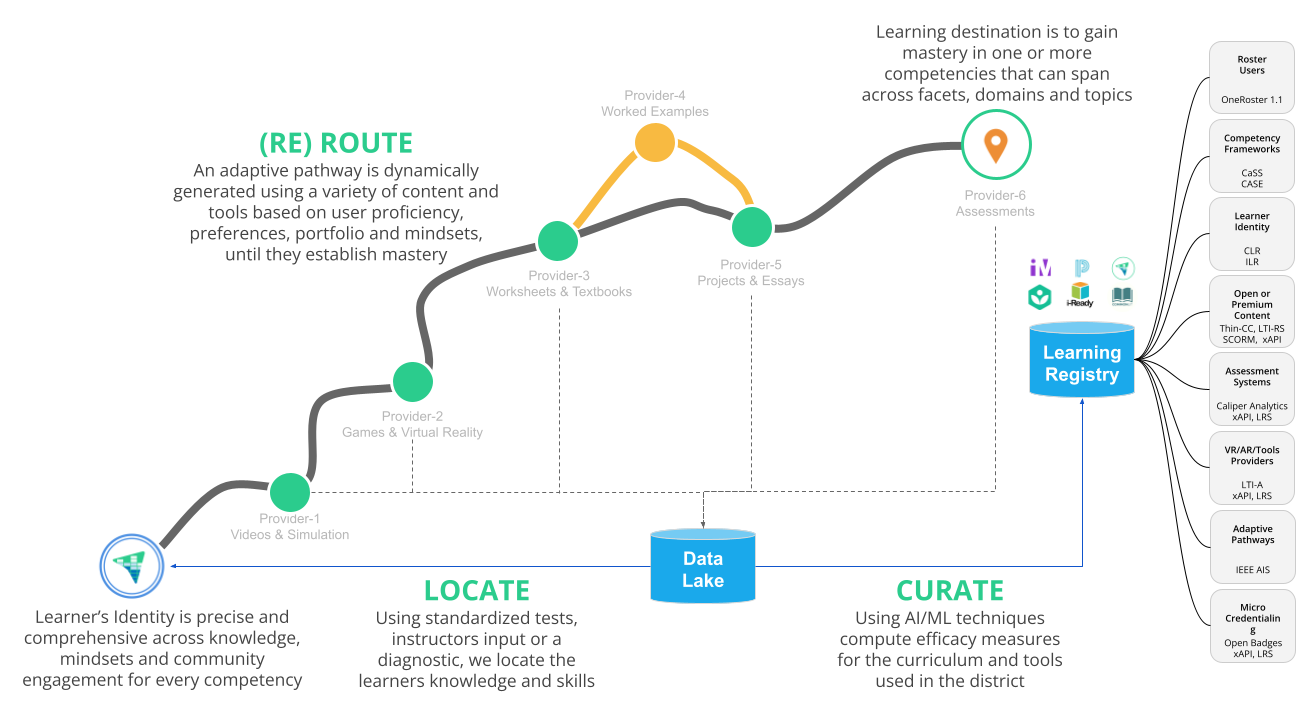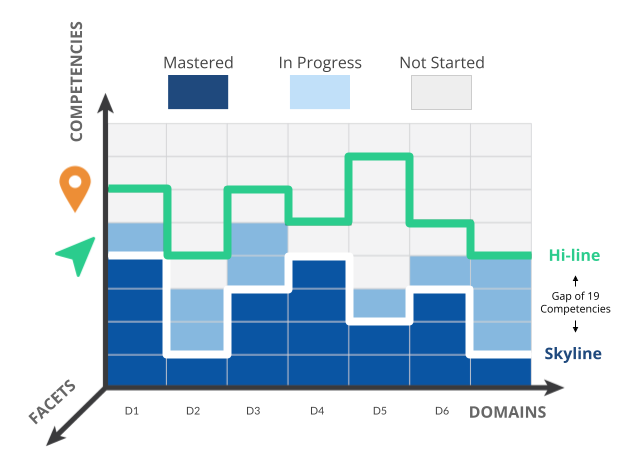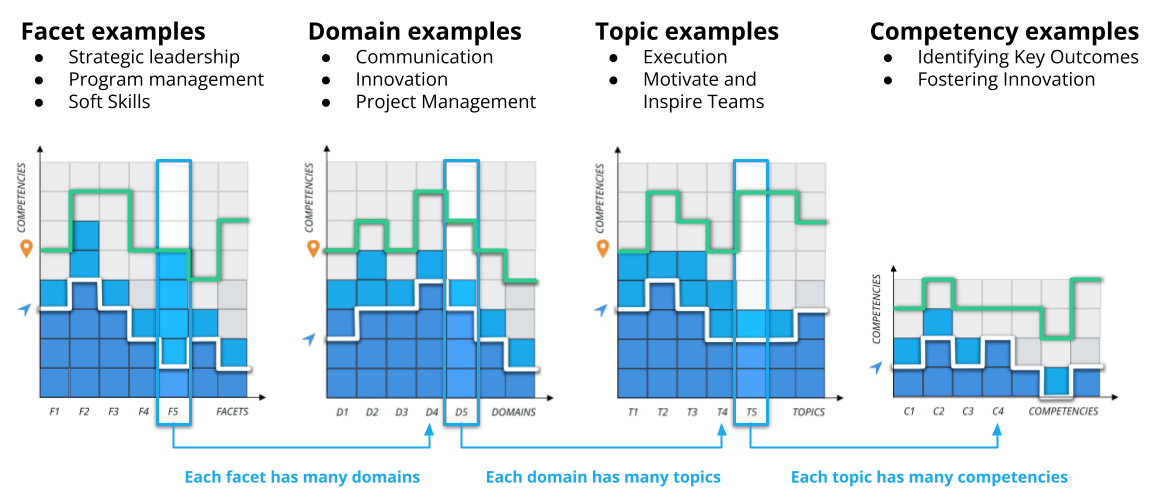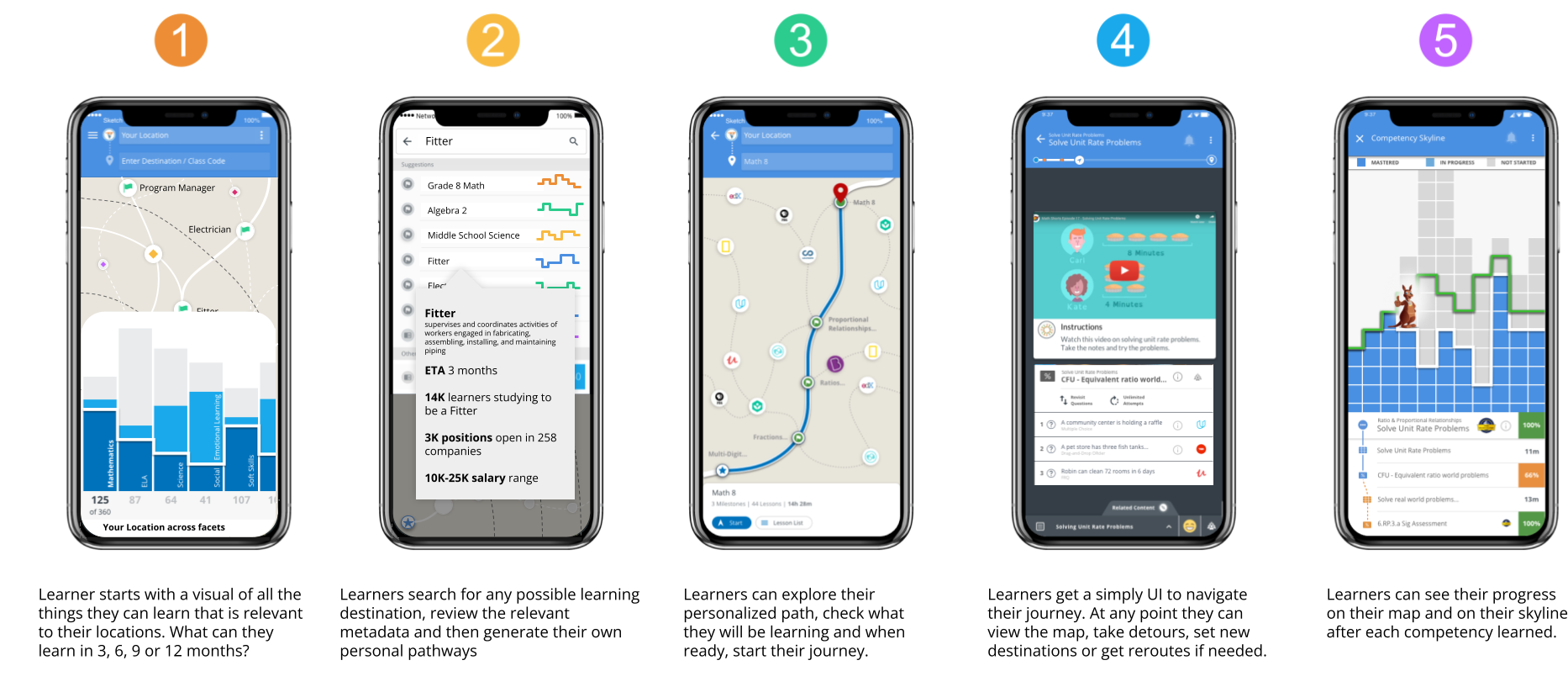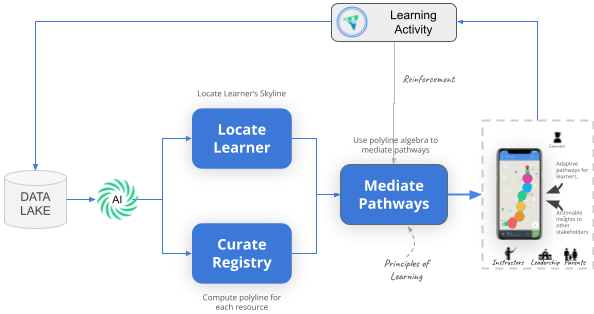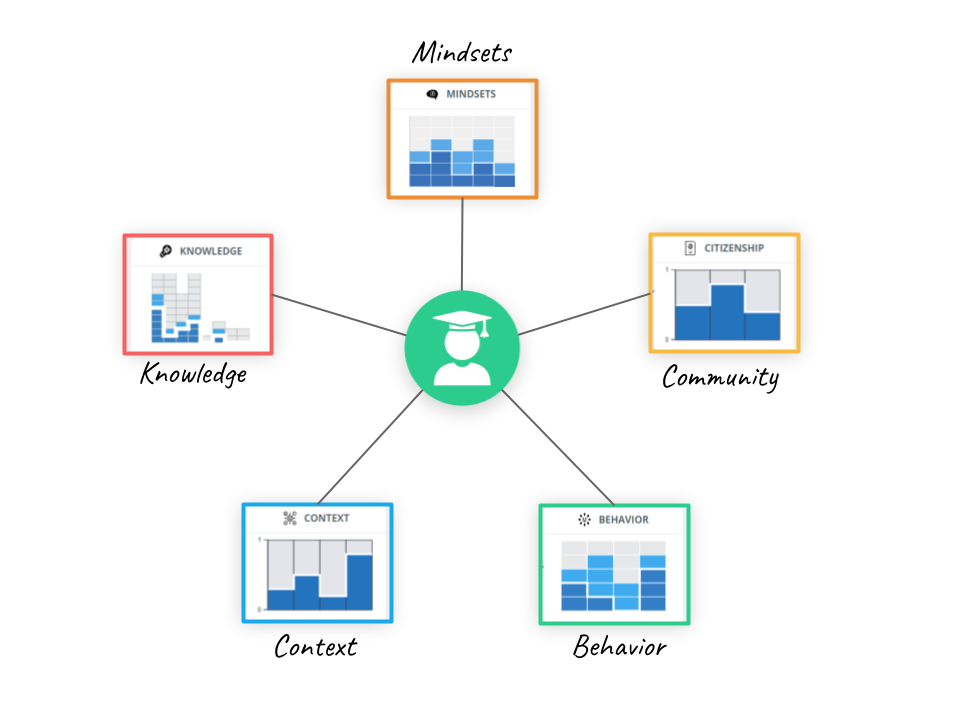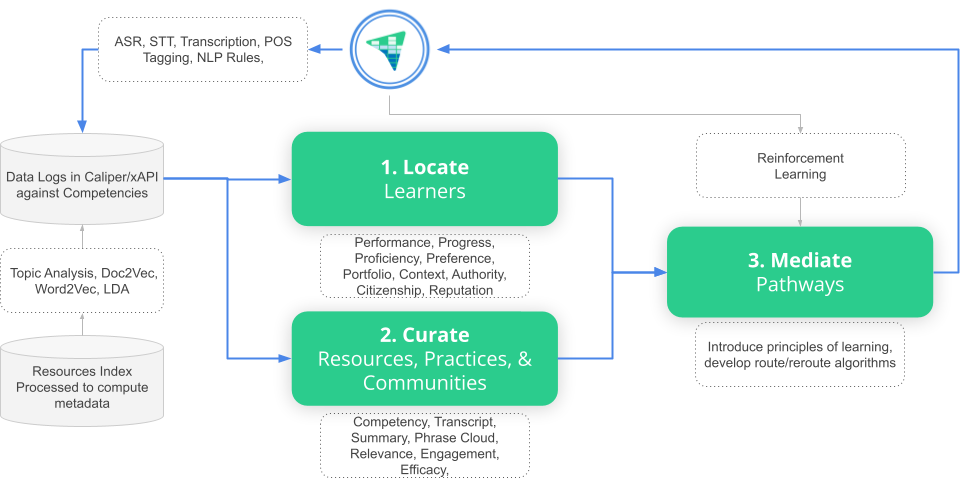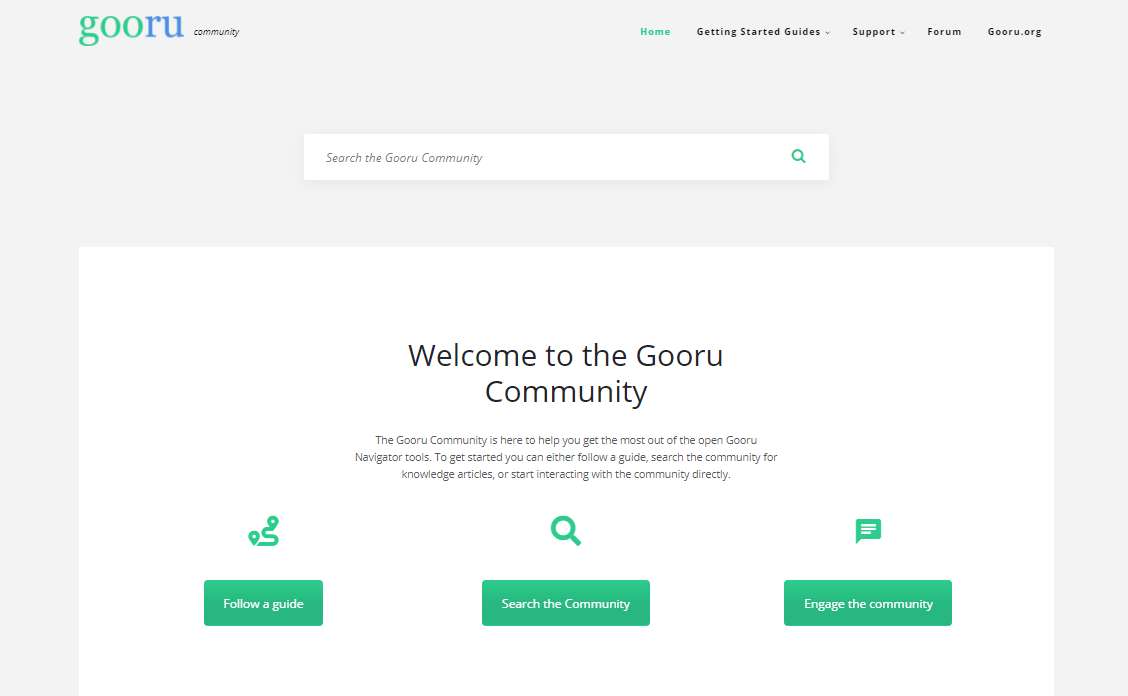Navigator AI Technology
Gooru’s AI technology provides robust personalized learning recommendations for use within adaptive learning tools.
Imagine if learners could learn anything they want, with the assurance that they will always achieve what they seek to learn.
Background:
Learning is complex and learners are diverse. Learning environments in K16 education, skills training and corporate learning around the world have failed to support learners at scale as they primarily focus on the learning destinations with digital courses, textbooks, curriculum, and standards and not as much on a precise and comprehensive understanding of the learner – in terms of their knowledge and mindsets for every competency. To tackle the systemic complexity of education, skills training, and professional development, Gooru provides a “Google Maps” for Learning based on proprietary Navigated Learning (NL) technology. NL locates learners comprehensively with high precision, provides adaptive pathways, and enables community engagement, so instructors and mentors can coordinate their support of the learner. Navigated Learning is an AI-based technology that updates its understanding of the learner for every competency in real-time in terms of their progress, performance, proficiency, portfolio, and preference. It then uses AI to operationalize the science of learning to make recommendations to learners. And, enables community engagement among instructors and mentors, so they coordinate their support of the learner. We implement Navigated Learning with Gooru Navigator- a GPS for Learning, that includes applications for learners, instructors, and mentors. Gooru Navigator applications are being used by 60+ collaborators to reach 7.5M learners worldwide.
Navigated Learning
The central approach with Navigated Learning (NL) is to precisely and comprehensively represent a learner’s current knowledge and mindsets by aggregating available data from digital and offline learning activities aligned to competencies. Then use AI and the science of learning to recommend adaptive pathways.
NL structures the learning space as a progression of competencies. For every facet of learning such as Math, English, Social-Emotional Learning, Soft Skills, Electrician, Cyber Security, Teacher Professional Development, and Leadership, NL defines a taxonomy of domains, topics, and competencies. Competencies are annotated with extensive metadata such as micro-competencies, dependencies, common struggles, depth of knowledge, and decay function. NL represents a Learner Identity as a polyline across all facets which we call a “skyline”. Learner’s skyline can be drilled down to see additional details about the learner by facet, by domain, by topic and by competency. The diagram below visualizes a learner’s skyline for a single facet that could be like Math, or Product Management, or Social-Emotional Learning.
Learners define their learning destination to be any set of competencies across facets that they want to master. We call this the “hi-line”. Hi-lines are also polylines and are often also predefined based on local norms such as courses (e.g. Grade-8 Math, Algebra), skills (e.g. Store Associate, Sales Clerk), and job-roles (e.g. Cybersecurity Expert, Sr. Software Engineer). Navigated Learning includes a polyline algebra that computes the functions on polylines such as cover that is a union of the two polylines or route as a sequence of competencies that learner needs to master to progress from their skyline to their hi-line.
AI-based Recommendation of Pathways
AI techniques are used to locate the learners, curate the registry of learning activities and recommend pathways to assure learning success. Learning routes are generated from a skyline to hi-line. Routes are personalized for every learner based on their skyline that encodes their knowledge, mindsets, preferences and portfolio. Routes are adaptive with reroutes based on the learner’s performance during their journey. The diagram below illustrates the flow that leads to making recommendations.
Locate the Learner
Gooru Navigator aggregates all available data aligned to competencies, to dynamically locate a learner across all dimensions and curate all learning resources. Gooru Navigator has established the Learner Identity Model (LIM). Gooru Navigator updates LIM for every learner in real-time by applying AI techniques on their activity stream data.
Compute Competency Graph
For every facet of learning, starting with a small corpus of learning resources, we build a two-dimensional competency map automatically using the content in the learning resources. As a first step, the textual content or the transcripts are extracted from these resources. The transcripts are cleaned and pre-processed and a set of tokens are obtained for each of these resources. Topic modeling techniques like LDA are then used to identify the topic clusters from the corpus of learning resources. We then use the keywords from each cluster as the topics that will constitute the X-Axis. To help sequence these topics on the X-Axis, we train a word embedding model (word2vec, GLoVE, fasttext) and compute the volume for each topic identified. The volume of a topic is the log-sum of the absolute values of its embedding vector. Similarly, document embedding models like Paragraph2Vec are used to generate resource embeddings for the learning resources in the corpus. These resource embeddings are used to compute the volume of each learning resource which is used to sequence them on Y-axis. Learning resources are then mapped to the competency map where the X-Coordinate is obtained by computing the weighted sum of the topic volume of the constituent topics of the learning resource and the Y-Coordinate is the resource volume computed for the resource.
Log Activity Stream Data
All distributed learning services log xAPI and Caliper data into a Data Lake that is created for each individual institution and is owned by the institution. Institution controls who gets access to what data in the Data lake. Individual DAP processors evaluate the different xAPI and Caliper data inputs and generate metrics such as time spent, performance scores, number of sessions by competency for further processing by the AI algorithms to compute the various metrics. Activity stream data includes work products for which we use OCR, NLP, NLU, and score against a rubric. We are continuing to improve the accuracy of this process. At present we enable manual scoring against a rubric. We use the activity stream data to compute competency measures of Map – Amount and variety of learning activities and assessments indicating the opportunity to learn and assess -; Interest – Learners studying the competency -; and Talent – Learners who have mastery in the competency indicating the supply of talent.
Establish Learner Identity
The learner identity is computed using neural networks and deep learning AI techniques. A data analytics processor (DAP) evaluates the events to compute the total time spent by the learner on competency and the number of individual sessions. For example, efficacy is computed using Bayesian Knowledge Tracing (BKT), and measures such as perseverance is computed as a hyperbolic tangent function of the total time spent on the competency. Similarly, DAP evaluates the learner’s performance in assessments for a specific competency and computes self-confidence as a measure of the performance variation across different attempts by factoring in the DoK levels of the assessments.
Curate Learning Registry
Content, Tool and Service providers can register their products in Gooru Navigator’s learning registry. Tenants can search and subscribe to the products and them to their tenancy. Gooru Navigator has established a Resource Efficacy Model (REM) and updates the REM for every resource that is indexed in its Learning Registry using activity stream data across all learners worldwide. It uses Deep Learning techniques to estimate the efficacy of learning resources.
Compute Activities Metadata
We use classification, clustering, neural networks, and deep learning AI techniques to compute and update activity metadata. Catalog enricher is where the created resources or new resources are crawled/ recrawled and enriched with necessary metadata and using machine learning algorithms contents will be classified with additional data about the resource, which will be used by search. Crawler consumes the events from the Kafka message bus, crawls the URL, extracts text and metadata of the resource. Transcript Service uses the crawled output (extracted text) of normal resources, for other types like embedded sites, audio resources, etc., transcript service crawls, extracts text, and stores them with completion status. Summarization Service uses the output of transcript (final extracted text) to generate the overall summary of the resource and persists it. Phrase Cloud Service with the help of transcript and summarization of the resource generates keywords and persists with the confidence of each keyword. The classification engine uses the output of the content analysis engine (transcript, summary, and phrase cloud) to classify resource metadata such as competency, lexile level, and audience.
Search Engine for Learning
Unlike the best of the search engines, Navigator has the advantage of a competency graph, a very well-curated catalog of activities, and a thorough understanding of the learner. This dramatically improves our ability to use the catalog of activities to rank it for every learner. We use all standard search techniques with our enhanced learner skyline to achieve more relevant search results.
Mediate Learning Pathways
Gooru then encodes principles of learning that recommend actions for a learner using curated resources. Gooru Navigator uses a weighted sum ensemble machine learning approach that combines the recommendations from multiple principles of learning, where the contribution of each principle is weighted proportionally based on the learner identity. Gooru Navigator is thereby able to provide adaptive pathways to learners and personalized interventions to instructors, guardians, and mentors.
Capture Principles of Learning
Navigator represents a growing list of principles of learning as event-condition-action rules. The rules have weights associated with them based on the learner’s profile. Event-condition-action rules “listen” to events and based on the condition of a learner, the models trigger actions which are suggestions based on the learning principles associated with the model. By operationalizing the learning principles, the suggestions and actions offered to the students are backed by learning theories and science. To identify and define learning/learner conditions, user journeys and maps are created through user interviews as well as user pathways within the system (Diwan et al., 2018). Learner conditions include a spectrum of struggling learners to those who need additional challenges to extended knowledge. Several of the overarching learning principles that guide curated system suggestions are: Students learn best when they have the opportunity to revisit an idea or concept multiple times, including revisiting in response to feedback and when revisiting is new flavors or variations on the original (e.g., Bruner, 2009; Reiser, 2004) and students learn best when their learning opportunity is a stretch learning experience; e.g., it builds on what they know and provides guidance but also extends or applies what they know in a new way, whether that extension is to a new context, a chance for them to make an inference (e.g., Vygotsky, 1978; NRC, 2019).
Suggest Learning Pathways
We rank the suggestions similar to search ranking as a weighted sum of signals where the algorithm uses reinforcement signals, learning principles along with learner profile, and curated catalog. The competency map is represented as a state-space, with each competency as a state of a Markov Decision Process (MDP). Mediate algorithm generates a ranked list of activities for a learner based on the learner-agnostic competency transition probabilities and learner-specific resource selection based on learner and activity vectors. Learning principles are factored in as a set of event-condition-action rules. Each rule is assumed to be implemented as the following: A rule takes in a set of resources (learning activities) as input and outputs a hashmap indicating a confidence score for each resource after applying the rule. We automatically generate learning pathways from available open learning resources, such that the generated pathways are semantically coherent and pedagogically progressive. Our approach has two components – a Greedy Generator and a Validator based on Support Vector Machine (SVM) and Long Short-Term Memory (LSTM) models respectively. The Greedy Generator chooses the next resource in the learning pathway based on local considerations and the Validator validates the learning pathway as a whole. They work in tandem with each other connected by a feedback loop. We then generate a “trailer” to encourage the learner to undertake a learning journey. Trailer generation takes the personalized activity stream to extract voice-over text, which is used for extracting title, video-text, and by the TTS engine. Then we compile all the inflow information with some user-defined meta-information to produce a trailer.
Reinforcement Learning
Mediate is implemented as a 2-level reinforcement learning mechanism. In the first level, the Mediate agent chooses a target competency; and in the second level, the agent chooses a target resource (learning activity) to be suggested. The “reward” for the choice made by the suggested agent is either {1, 0, -1} corresponding to the learner choosing the suggestion, the learner ignoring the suggestion, and the learner canceling the suggestion.
The diagram below highlights the AI techniques used in the different steps of the flow.
Products & Impact
Gooru provides three products to reach lifelong learners, worldwide. First, Navigator for School that includes all the applications for learners, teachers, parents, and school leadership, open curated content for US K12 Math, Science and English Language Arts (ELA), teacher and staff training, and email support. This enables schools to immediately understand the gaps in learning for every student and fill the gaps using open education resources. Second, Gooru Navigator is provided as a hosted platform that is used by companies, non-profits, and governments (that we call as “collaborators”), who bring their competency frameworks and content to support their users. Collaborators provide all training and support for their users. Third, Gooru provides a source-code licensing of the Navigated Learning Technology that edTech partners integrate with their products to provide adaptive pathways to their customers.
Navigator for Schools with a comprehensive solution for US K12 schools and districts has over 2.23M K12 users across 48 contiguous states. Gooru Navigator is being used as a platform for after-school tutoring in the US by Sylvan Learning, by California State University, Long-Beach to provide College-Readiness Skills, Gram-Tarang a skill training provider trains Automotive workers, Electricians, and Sewing machines operators. SAP is using Gooru Navigator to train their engineers in Brazil, China, and Silicon Valley. India Education Collective (IEC) is using Gooru Navigator to facilitate learning in Zilla-Parishad (rural Indian government) schools across 15 states in local languages. Education technology providers license the source code to the Navigated Learning technology. For example, Pearson uses it in their product called Digital Collections, Advanced Distributed Learning in the US Department of Defense uses, and Hovercam packages it with their smart board products that they sell to US K12 schools.
Need Help?
The Gooru Community is here to help you get the most out of the open Gooru Navigator tools. Get started today!
